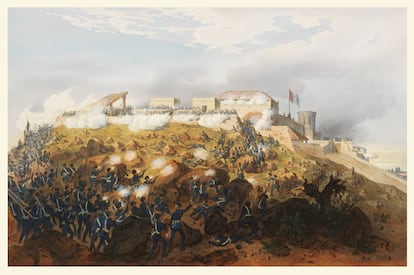The Mexican-American War ended 175 years ago: How did Mexico lose half its territory?
The United States came close to annexing the whole Mexican territory after the war. This is how they got half of it

The Treaty of Guadalupe Hidalgo officially put an end to the Mexican-American War 175 years ago. The invasion of Mexico by the United States Army followed the annexation of Texas in 1845, and lasted for two years. Major General Winfield Scott captured the capital Mexico City in September 1847, which led to peace negotiations. The conditions included the requirement that Mexico would cede 55 percent of its territory, including the present-day states of California, Nevada, Utah, and most of Colorado, New Mexico, and Arizona. Mexico also had to relinquish all claims to Texas, recognizing the Rio Grande as its northern boundary. In turn, the U.S. paid $15 million.
The Treaty of Guadalupe Hidalgo brought about significant border changes and marked a new era for both the U.S. and Mexico. However, why did Mexico have to cede half its territory?
Reasons for the Mexican-American War
Instability in northern Mexico and American expansionism under President James K. Polk, who had successfully annexed the then-Republic of Texas and the Oregon Territory, led to the Mexican-American War. After the annexation of Texas, Polk sought to acquire the Mexican territory of Alta California and Santa Fe de Nuevo México and sent John Slidell, a representative, to Mexico City with an offer of $25 million to the Mexican government, proposing the acceptance of the Rio Grande border in Texas and ceding the provinces of Alta California and Santa Fe.
At that point, Mexico had not yet recognized Texas’ independence. In México, President José Joaquín de Herrera was viewed as a traitor for considering the peaceful settlement of the Texas matter with Slidell, and he was deposed. His successor, Mariano Paredes y Arrillaga, reaffirmed México’s claim to Texas.
President Polk ordered General Zachary Taylor, who had previously been sent to Texas to protect the disputed land, to advance to the Rio Grande. Ulysses S. Grant, then an army lieutenant in Taylor’s army, later revealed that the goal was to provoke the outbreak of war without attacking first, in order to weaken any political opposition to the war. By then, several members of the government were against the war with Mexico and the acquisition of its territory, including the Whigs. In fact, the war became a partisan issue and played a role in the origins of the American Civil War.
American advances were met with Mexican attacks. Polk declared war, citing that “Mexico [...] has invaded our territory and shed American blood upon the American soil.” A freshman Whig Congressman from Illinois, Abraham Lincoln, challenged that assertion, calling it “a bold fascination of history.”
President Paredes issued a declaration of a defensive war on April 24 and a manifesto on May 23, 1846, which some considered the beginning of the war. The Mexican Congress declared war on July 7, 1846.
The end of the war
Militarily outnumbered and with many cities occupied by the Americans, Mexico couldn’t defend itself in conventional warfare. The United States considered annexing all of Mexico, but there were fierce objections in Congress on racial grounds. South Carolina Senator John C. Calhoun argued that absorbing Mexico would threaten U.S. institutions and the character of the country, stating, “We have never dreamt of incorporating into our Union any but the Caucasian race—the free white race”. Rhode Island Whig Senator John Clarke also objected, saying: “To incorporate such a disjointed and degraded mass into even a limited participation with our social and political rights, would be fatally destructive to the institutions of our country. There is a moral pestilence to such people which is contagious – a leprosy that will destroy [us].”
Polk appointed Nicholas Trist as his negotiator, sending him to Mexico with orders to arrange an armistice. The proposed restitution ranged up to $30 million, depending on Trist’s ability to secure Baja California, additional southern territory including Alta California (already conquered under the Treaty of Cahuenga), the Nueces Strip (the region between the Nueces River and the Rio Grande in South Texas), and New Mexico. However, both President Polk and General Winfield Scott expressed dissatisfaction with Trist’s work and ordered him to leave Mexico.
Undeterred, Trist penned a letter to Washington, detailing his reasons for staying. Ultimately, he successfully negotiated the Treaty of Guadalupe Hidalgo on February 2, 1848. This treaty was crafted during the administration of President Manuel de la Peña y Peña, who assumed office after Herrera was overthrown. In these terms, a smaller cession of Mexican territory was agreed upon, contrary to the desires of many expansionists. As part of the agreement, the U.S. government committed to paying Mexico $15 million and assuming the debts owed by the Mexican government to American citizens. Notably, all of Baja California was left to Mexico, much to the dissatisfaction of Polk, who reluctantly approved the treaty. The U.S. ratified the treaty on March 10.
In México, the majority of congress supported the government’s decision to make peace under the Treaty, considering it a national necessity as the country couldn’t continue the war without facing certain defeat and risking the loss of the entire territory. The Treaty was approved and ratified by Congress on May 19, effectively ending the war. The ratifications were exchanged on May 30, and the treaty was proclaimed on July 4, 1848.
The territories the U.S. received comprised some or all of the present-day U.S. states of Arizona, California, Colorado, Nevada, New Mexico, Utah, and Wyoming. The amount of land was further increased due to the Gadsden Purchase of 1853, which ceded parts of present-day southern Arizona and New Mexico to the U.S.
Trist later commented on the treaty: “My feeling of shame as an American was far stronger than the Mexicans’ could be”. Upon his return, he was fired for his insubordination.
Sign up for our weekly newsletter to get more English-language news coverage from EL PAÍS USA Edition
Tu suscripción se está usando en otro dispositivo
¿Quieres añadir otro usuario a tu suscripción?
Si continúas leyendo en este dispositivo, no se podrá leer en el otro.
FlechaTu suscripción se está usando en otro dispositivo y solo puedes acceder a EL PAÍS desde un dispositivo a la vez.
Si quieres compartir tu cuenta, cambia tu suscripción a la modalidad Premium, así podrás añadir otro usuario. Cada uno accederá con su propia cuenta de email, lo que os permitirá personalizar vuestra experiencia en EL PAÍS.
¿Tienes una suscripción de empresa? Accede aquí para contratar más cuentas.
En el caso de no saber quién está usando tu cuenta, te recomendamos cambiar tu contraseña aquí.
Si decides continuar compartiendo tu cuenta, este mensaje se mostrará en tu dispositivo y en el de la otra persona que está usando tu cuenta de forma indefinida, afectando a tu experiencia de lectura. Puedes consultar aquí los términos y condiciones de la suscripción digital.
More information
Archived In
Últimas noticias
Most viewed
- Sinaloa Cartel war is taking its toll on Los Chapitos
- Oona Chaplin: ‘I told James Cameron that I was living in a treehouse and starting a permaculture project with a friend’
- Reinhard Genzel, Nobel laureate in physics: ‘One-minute videos will never give you the truth’
- Why the price of coffee has skyrocketed: from Brazilian plantations to specialty coffee houses
- Silver prices are going crazy: This is what’s fueling the rally











































